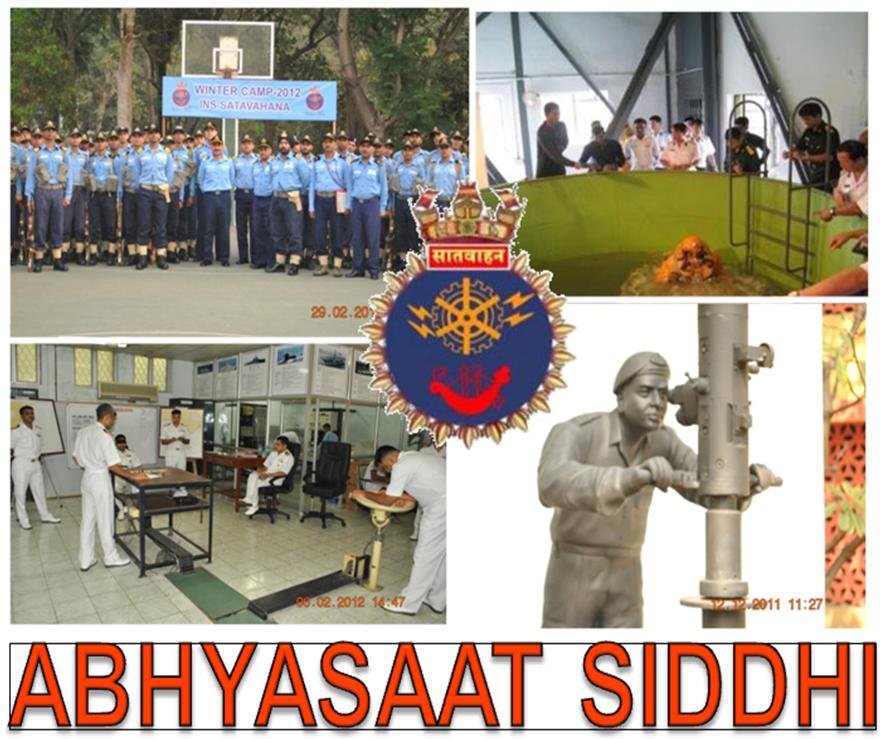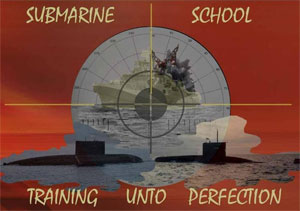INS Satavahana

Historical Background
The establishment derives its name from the “SATAVAHANA” dynasty that once ruled the eastern coast of peninsular India (184 BC to 300 AD). The name of first Ruler of the dynasty was Srimukha Satavahana. During the reign of Satkarni, the third Satavahana King, the Indian sails ventured off the far eastern Islands of Katah (Kadeh of Malaysia), Karapura (Campher Islands), Suvarna (Sumatra) and other Islands of Indonesians Archipelago where they established flourishing colonies. The crest of the establishment contains the motif taken from an old “Satavahana” Coin.
The unit was originally an integrated training establishment (Circar II) set up on 11 March 1974 for the purpose of training officers and sailors for ships and submarines of Soviet origin. The establishment was later named INS Satavahana and commissioned on 21 Dec 1974. In 1986 it was decided to disband the surface training school and convert INS Satavahana to an exclusive submarine training establishment. Presently, the unit is the premier submarine training establishment of the Indian Navy.
Command and Control
Till the year 1999, the administrative control of this unit was exercised by the FOCINC East whereas the FOSM was responsible for complete submarine training. However, Satavahana primarily being a training base, the command structure was changed in 1999 wherein functional control of training was assigned to Flag Officer Commanding-in-Chief, Southern Naval Command. The administrative control of the unit was retained by the Flag Officer Commanding-in-Chief, Eastern Naval Command and. The Flag Officer Submarines provides necessary support to FOC-in-C South for technical aspects of submarine training.
Submarine Training
 The primary role of this frontline training establishment is to impart world class submarine and escape training to meet the stringent performance objectives and exacting standards of the Submarine Arm. It is the only integrated training establishment in the Navy, as it carries out training for all branches of officers and sailors of the Submarine Arm. Training in INS Satavahana is carried out by the Submarine School (SMS) and the Escape Training School (ETS) and the School of Advanced Undersea Warfare (SAUW). SAUW was established in Dec 2006 inside the premises of INS Satavahana, to train the crew of submarines of the nuclear submarines. Today SAUW has developed into a state of the art training school with excellent simulators and training infrastructure. The training set up for the Scorpene class and the P 75 (I) of submarines class of submarines is also being set up at Satavahana. Training is conducted for personnel from foreign navies, thus making it the most sought after submarine training establishments in the whole of South East Asia.
The primary role of this frontline training establishment is to impart world class submarine and escape training to meet the stringent performance objectives and exacting standards of the Submarine Arm. It is the only integrated training establishment in the Navy, as it carries out training for all branches of officers and sailors of the Submarine Arm. Training in INS Satavahana is carried out by the Submarine School (SMS) and the Escape Training School (ETS) and the School of Advanced Undersea Warfare (SAUW). SAUW was established in Dec 2006 inside the premises of INS Satavahana, to train the crew of submarines of the nuclear submarines. Today SAUW has developed into a state of the art training school with excellent simulators and training infrastructure. The training set up for the Scorpene class and the P 75 (I) of submarines class of submarines is also being set up at Satavahana. Training is conducted for personnel from foreign navies, thus making it the most sought after submarine training establishments in the whole of South East Asia.
Command Responsibilities
Apart from training, the unit has been entrusted with the upkeep and running of various facilities of the Eastern Naval Command. The Indian Naval Sports Control Cell (Vizag), Command Auditorium Samudrika, the Command Stadium, KV II in 104 area, Little Angels School in Dolphin Hill, Conduct of Navy Mela every year are a few of these. The latest edition to these responsibilities is the Eastern Naval Command Polo and Equestrian Training Centre (ENPET) inaugurated at INS Satavahana in Dec 09. The ENPET conducts the equestrian training for all service personnel and their families of the command. This facility has sixteen horses and is well tilized by personnel of the Command.
Achievements
The unit has successfully dovetailed her primary role of training and assigned.
Tower of Confidence : The Escape Training Tower command responsibilities and has set the highest standards in both.
- Adventure Camps The adventure camps conducted biannually as part of the training curriculum are a major demonstrator of naval presence in the Naval Advanced Operating Base (NAOB) near Rambilli village.
- Medical Camp Medical camps conducted as part of the training camps has hugely benefited the local populace near Rambilli village. These initiatives have helped in spreading the awareness and goodwill among villagers.
- Training Models and Simulators The training models and Simulators at Satavahana have evolved to help the submarine squadrons and the repair yards immensely in defect identification and rectification in addition to helping in possible ‘Additions and Alterations’ of equipment.
- Diving Facilities The training facilities at the Escape Training school have been utilised for work up of command diving teams, aircrew survival drills, Hyperbaric Oxygen Therapy, etc.







